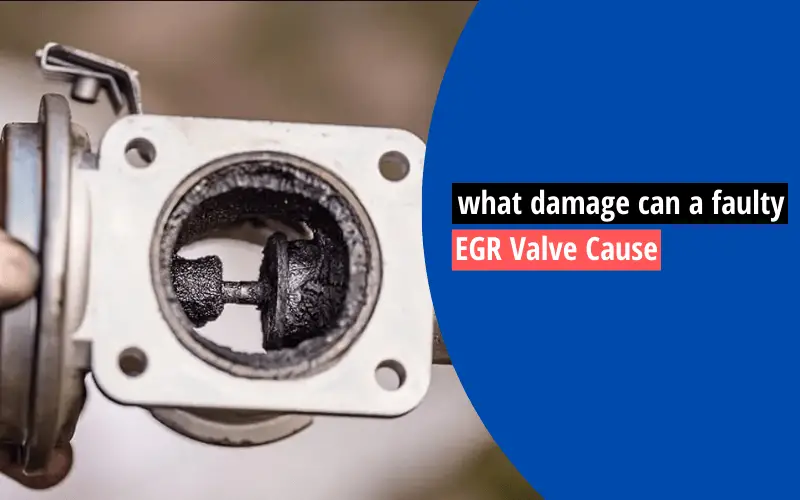One day I was driving my car and found some bad smell is coming from the engine. First, I didn’t care about this, but when the engine was overheated and noticed some problems, I took my vehicle to the repair shop. Then I learned that my car’s EGR valve failed, and it had already damaged some of my engine function.
I know it sometimes happens with you, so I have shared what damages can cause the faulty EGR valve cause to make alerted.
How Does An EGR Valve Work?
When your engine burns fuel at a very high temperature, nearly or over 1370°C, the engine starts producing the deadliest gas, Nitrogen Oxide. For reducing toxic and lethal NOx gas, modern vehicles incorporate the Exhaust Gas Recirculation (EGR) valve into their engine design. So, it’s a method to prevent or control Nitrogen Oxide emissions.
EGR acts in two ways: open and closed. When the engine starts up and attains the correct operating temperature and speed, EGR begins regulating exhaust gas flow. On the other hand, EGR closes exhaust gas flow when the engine is slowed down or stopped.
Now come to the point how EGR helps; EGR lowers the Oxygen content so that Nitrogen can’t exceedingly mix with the oxygen at high temperature. It also increases water vapor to reduce peak combustion temperature.
Moreover, as at high temperatures, the naturally inert gas becomes reactive and creates harmful NOx, EGR minimizes NOx by allowing exhaust gas to re-enter the intake manifold. It slower the mixture burns and lowers the combustion chamber’s temperature by almost 150°C and becomes more efficient.
What Are The Types Of EGR Valve?
EGR valve is found in two types:
1. Vacuum operated EGR valve,
2. Electronically controlled EGR valve.
Vacuum-controlled EGR valve:
It is mainly found in older vehicles, and a computer-controlled solenoid regulates the vacuum. It has three types:
- Single-diaphragm EGR valve: It has a single, spring-loaded diaphragm that allows the flow of exhaust gas into the intake manifold.
- Negative back pressure valve: A negative backpressure EGR valve has two diaphragms. It helps to prevent negative exhaust pressure.
- Positive back pressure valve: It is quite similar to the negative backpressure EGR valve. Positive exhaust acts on the second diaphragm and closes the bleed valve.
Electrically operated EGR valve:
It is found in modern vehicles. It has two types. They are:
- Pulse-width-modulated solenoid: It is opened by an electric solenoid and closed by the spring. It controls EGR flow reasonably well.
- Stepper motor EGR valve: ECM operates the stepper motor when the EGR flow is needed. And the stepper precisely controls the EGR flow.
What Damage Can A Faulty EGR Valve Cause?
First of all, I’ve found out why the EGR valve gets faulty. The EGR valve becomes failed for remaining open, closed, or clogged. If the valve sticks remain open, it creates a vacuum leak. When it is open, the chamber gets flooded with exhaust gas and affects vehicle functions. Another problem occurs when the EGR is stuck closed as vast amounts of NOx are emitted, disrupting engine timing.
Again, sometimes EGR gets clogged by carbon and debris. You can find faulty valves by checking engine light indicator or emission test or even observing engine performance.
Faulty Exhaust Gas Recirculation valve causes:
Poor engine performance:
Faulty EGR has issues with the engine’s performance. It produces erratic performance in your vehicle. It creates acceleration difficulties and even a reduction in the power engine when stepping on the gas pedal. Poor EGR can also create knocking noises in the damaged engine.
Overheating:
It also causes engine overheating. Overheating leads to the breakdown of engine oil and also leaks the lubricating oil into the combustion chamber. The engine can be broken down by getting overheated.
Fuel odor:
EGR creates fuel odor if continuously exhaust gas flow into the intake manifold. You will get irritated by the terrible smell, and also it can affect your health.
Rough idle:
When too few or too many exhaust gasses are entering the chamber, it causes rough idle. Rough idling also happens when the valve is found open or closed.
Hydrocarbon emissions:
When the valve is stuck open, or the fuel injector leaks or there is a bad oxygen sensor, you will find increased hydrocarbon emissions. It also increases fuel consumption while open. But when the valve is closed, there would be excessive NOx.
Now, look for how to clean the EGR valve. You can clean it very easily without going repair shop. Some hand tools, elbow grease, and good quality EGR system cleaners are enough to clean the EGR to keep it damage-free regularly.
FAQs
Can a bad EGR valve cause a misfire?
Yes, if the EGR valve is leaked, it can cause a misfire.
Can a bad EGR valve cause overheating?
Yes, overheating occurs when the valve restricts the flow of gas through the EGR cooler.
Can a bad EGR valve cause engine damage?
A clogged EGR valve disrupts the vehicle’s air-fuel ratio, and it damages the engine.
Can you still drive with a faulty EGR valve?
It would be best if you didn’t drive with faulty EGR as it is risky and creates many problems like overheating, emissions, and engine damage.
What happens when the EGR valve stuck open?
EGR valve stuck open can cause rough idling, and the exhaust gas cycle back into the chamber.
Conclusion
Now, you know the consequences when your vehicle’s EGR valve gets faulty. So, be prepared whenever you find out anything fishy, do an EGR replacement, or take your vehicle to the professionals.

